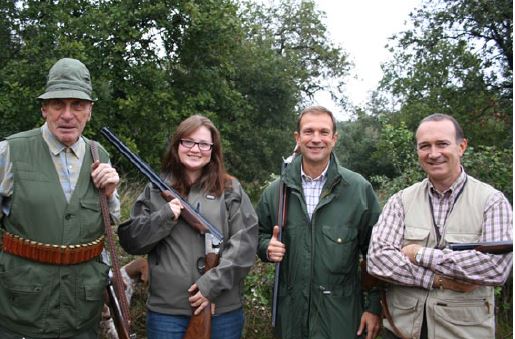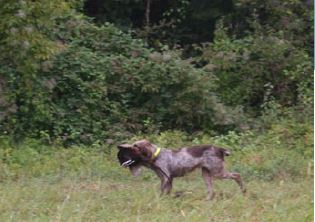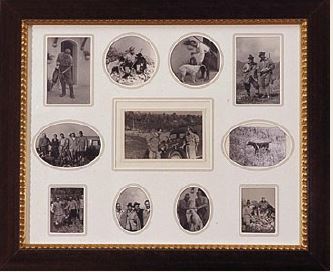
I hunted Arzaga twice, first in the fall of 2009 with Steve Lamboy, director of Zoli USA, and Paolo Zoli and his father, Giuseppe. Last fall, I hunted Arzaga with the Zolis, my daughter, Alexandra and with Roberto, its owner. This article details my second visit.
The hunting club Arzaga Drugolo was named after the 12th century estate that included the Drugolo Castle, presently owned by Baron Della Quara. The modern club was founded in 1926 from land belonging to the Della Quara family. In the 1950s, Carlo Beretta was an owner with Roberto’s father. Presently there are about 40 members. The preserve is located in the village Soiano del Lago in the province of Brescia. The territory extends to the edge of Lake Garda. The terrain is predominantly hilly and the vegetation is comprised primarily of natural woods and some agriculture acreage used mostly for corn and wheat production.
The first concession released for the Reserve of Hunting Arzaga Drugolo is dated 1786, assigned by the Venetian Republic to Count Averoldi, then owner of the estate. The concession was valid for only a few years and was revoked with the arrival of Napoleon at the beginning of the 1800s.
In 1926, the King of Italy reissued a hunting concession for the estate to Count Averoldi, a descendant of the earlier Count. The concession was held for 10 years and then, in 1936, passed to Mario Ferrata, Roberto’s father.

Hunting pheasant and partridge and the elusive woodcock at Arzaga is unlike any wing shooting experience I’vehad or read about. Entry to the shooting grounds is about one mile from the aged and austere clubhouse. We leisurely walked to the shooting area, stepping cautiously on the well-worn dirt path to avoid puddles and thick mud from the previous night’s rain. Mist hung in the air like a shroud.
On the way, we passed olive orchards and a stand of magnificent apple trees still bearing luscious fruit. On our left, near the entry, were plantings of pinot nero and syrah vines, now brown and seemingly devoid of life, their robust grapes having been harvested only weeks before.
Vines and olive groves and fruit trees yielded to dense...
stands of oak and pine and brush as the path gained slight elevation in the hunting preserve. Oak and fragrant pines and underbrush seemed as dense as Sleeping Beauty’s metaphoric Enchanted Forest. Trees, 60 to 70 feet tall, formed canopies over the trails and allowed only slivers of light to pierce the dank cool atmosphere.

The musky fragrance of damp earth and moist foliage tickled the nose and caused the nostrils to wrinkle. These aren’t the Amarillo fields of the Panhandle or the horizon-punching lands of the Dakotas, and we’re surely not in Kansas anymore, Toto! We were pheasant and partridge hunting in northern Italy.
Vero de Micheli, the dog handler and guide, unleashed three frisky, yet obedient Labradors—Chicca, Pea and Roberto’s new puppy, Pulce, which is Italian for a little flea. The dogs promptly jumped and muddied his oiled jacket. Vero pushed them away as he muttered a phrase that I didn’t understand but the dogs did. They ran frenetically through the brush and around the trees. That’s where the birds are.
The dogs yelped as they slashed through brush to a tree a few yards off the path. Two majestic roosters blasted from a tree and flew towards a cornfield, their wings slamming the air like helicopter rotors. The minimal opening of space denied me any shot, but Paolo and his father were in position on the edge of the stubble field. Each fired one shot. Paolo missed; Giuseppe’s bird fell like an anvil.
Each fired one shot. Paolo missed; Giuseppe’s bird fell like an anvil.
Giuseppe’s father, Antonio, founded the modern gun-making firm Antonio Zoli soon after World War II ended. The current factory is in Gardone Val Trompia, the arms center of Italy. Paolo, his son, is now the director. Under Paolo’s leadership, the firm has gained stature as one of Italy’s finest sporting arms makers and boasts a product line of double rifles, shotguns, bolt rifles and combination guns.
Steve Lamboy introduced me to Paolo Zoli at the 2009 Safari Club...
Convention. I liked him immediately. He radiates an aura of honor and his passion for family, life and building fine guns is palpable. Paolo allowed me to shoot his personal shotgun, a Super Luxus 20 bore over/under boasting jaw-dropping wood and subtle ornamental engraving.

Alexandra carried an agile Zoli Columbus 20 bore game gun. She had shot with me on a dove and pigeon hunt in Argentina a few years ago. Her skills were sufficient for this close fast shooting. Alexandra would stay in Gardone for another few months to study Italian, make friends and travel. A stroke of good fortune, Steve Lamboy’s wife, Elena, arranged for Alexandra to live at the home of Cesare Giovanelli, founder of the renowned engraving studio, Bottega Incisioni C. Giovanelli.
Vero kept the dogs focused as we continued walking on the muddy path to the edge of a small cornfield. The dogs’ barking became more aggressive. I turned in their direction. A partridge erupted from the cornhusks, quartering and rising away from me, presenting a common sporting clays shot. I pivoted, shouldered the gun and fired. Success!
Such a vista inspires those luscious moments when one kneads thoughts like fine brioche dough and searches for meaning in soul-churning beauty
The Labs leaped through the moist field to retrieve the bird, creating a wake of sprayed water droplets as if from slalom water skiers. Two blasts shrieked from Vero’s whistle and they dutifully returned, tails wagging like a musician’s metronome on mescaline.
A few minutes later, we came to rise above a cornfield, presenting an unobstructed view of Lake Garda. It was almost 11:00 in the morning and the sun battered through the slate sky. I unloaded my shotgun, muzzle on my right boot and stood alone, absorbing the beauty of the place. The warmth had burned off the mist and Garda glistened like a patch of diamond dust.
Such a vista inspires those luscious moments when one kneads thoughts like fine brioche dough and searches for meaning in soul-churning beauty. Soiano del Lago is located between...
Gardone Val Trompia and Verona, home to Shakespeare’s Romeo and Juliet. Garda is the largest lake in Europe, and many folks who seem to know about these things say it is the most beautiful.
Garda was a favored retreat for rich Roman families from Verona and still attracts wealthy patrons to its world-class golf courses and hotels that can cost $2,000 a night. Roughly equidistant between Venice and Milan, it is part of the Lombardy region on the west and the Veneto region on the east. The sky-stabbing Dolomite Mountains can be seen towering above the lake.

Paolo waved to me. My moment of solitude ended and I joined the group. We continued on a gently upward sloping path made tunnel-like by trees and foliage until we came upon a corn field of relatively considerable expanse which transitioned into several acres of grass. The dogs barked furiously. I turned in time to see a pheasant rocket skyward like a missile.
In a flash, Giuseppe raised and fired, hitting the bird before it cleared the trees. Giuseppe was shooting a stunning Hollandstyle 20 bore sidelock that he built. On the action’s underside was a bulino engraving of the Zoli family in a hunting scene, brilliantly executed by Angelo Galeazzi, one of Italy’s legendary engravers and a friend of Giuseppe dating back to childhood. Giuseppe is 83. Later, I learned that he had been a member of the Italian national team. His perfect shot proves inspiring for those shooters who have more sand in the lower section of life’s hourglass than in the top.
Pea and Chicca jumped harmoniously like a figure skating pair performing double lutzes; I pivoted as a pheasant exploded from thick brush, gaining speed and altitude rapidly toward the top of the trees at the edge of the woods. The window of visibility was minimal. I swung through the bird, gained two feet of allowance and fired.
“Elegante, Michael!” Paolo cheered. I was pleased. When you make a perfect shot with a beautiful gun on a beautiful day, all is right with the world, at least for a moment.
I became aware that Alexandra and Roberto were not in sight. I then saw their heads and shoulders...
moving to my right above cornhusks perhaps 300 yards away. Two shots were fired in rapid succession. Moments later, they emerged from the cornfield as if from a fog, Roberto grinning like fireworks and holding a huge hare. Pulce danced around Roberto’s feet.

With manifest love, Roberto petted his energetic little partner. “Pulce is for the next generation,” he said. “This is for my children. Pulce is a special dog.”
While chatting with Paolo a pheasant flushed directly over our heads. We looked at each other, shrugged, and continued discussing how best to use olive oil when preparing sea bass. If it takes a hunting outing to have a lingering conversation with a dear friend, then the hunt is worth every moment.
It was time to return to the clubhouse and enjoy the ritual of a Brescian Sunday lunch. We had seen only three dozen or so birds and had fired fewer shots but each shot counted. Each had meaning.
Lunch Bunrcehs Tiiapnicaa
History drenched the clubhouse. It was old; it smelled old and it had that exquisite quality indicating that marvelous hours had been enjoyed there. A well-used wooden gun rack, scarred from butts and barrels, was attached to a wall near a window. Photographs of club dignitaries covered the walls, including those of royalty and the Beretta and Zoli families dating back two-thirds of a century. Italy’s most prestigious names in the gun trade as well as nobility and diplomats have hunted at Arzaga. Today the preserve entertains people from all the parts of the world.
We were joined by Roberto’s beautiful wife, Nicoletta, a vivacious and energetic woman, Silvia and Laura, the Ferrata’s two charming daughters and two young couples, late 20s I’d guess, who were friends of the Ferratas. Roberto introduced the couples and eloquently editorialized that the hunting sports and respect for their traditions will dissipate unless they are passed to the next generation. I enthusiastically raised my glass of Terre di Franciacorta Cabernet.
Franciacorta Cabernet. Plates of warm bread, sausage and ham, capers, marinated onions, pickles, finely grated parmesan cheese and fresh...
aromatic unpasteurized gorgonzola cheese that oozed honey-like were in neat rows on the large oak table. Bowls of olive oil, a first pressing named mosto, were strategically placed near the bread. Bottles of wine and sparkling water appeared on the table like stalagmites. Thus began our tipica Bresciana lunch, typical of the Brescian region.
The Brescians are wine-lovers and produce array of grapes such as Barbera, Marzemino, Schiava and Sangiovese.
Teresa, our chef, introduced herself as she presented the first course, meat-stuffed ravioli with black truffles soaked in truffle oil. They were ethereal and accompanied by warm polenta with mushrooms. The main dish was a traditional beef presentation, kind of like a roast, bathed in a sauce comprised of olive oil, capers, garlic, anchovies and parmesan cheese. It was good! I learned that the olive oil, green and tart and with a fragrance more seductive than those from the finest perfumeries, was made from olives grown on Teresa’s groves in nearby Garda.
All the wines were made locally in the Garda and Franciacorta regions in Lombardy. They are small geographic areas to the southwest and are favored by a unique micro climate with cool consistent temperatures influenced by the two large lakes, Garda and Iseo.
The Brescians are wine-lovers and produce array of grapes such as Barbera, Marzemino, Schiava and Sangiovese. The hills of Lake Garda have two areas of high quality production, Lugana, known for its dry white wines and Garda Classico, which produces reds, whites and rosés.
We also had several sparkling wines produced in nearby Franciacorta.
We also had several sparkling wines produced in nearby Franciacorta. Its reputation has been built on the outstanding bottlefermented sparkling wines made using the Metodo Franciacorta, based on the classic champagne method. The wine undergoes a costlier second fermentation in the bottles rather than in a vat, leading to smaller more plentiful bubbles and a more subtle taste. Franciacorta sparkling wines are made of Chardonnay grapes and sometimes Pinot Bianco and Pinot Nero grapes are added for different styles.
different styles. Our sumptuous and filling meal ended with a selection of grappas. Grappa is made as a byproduct of wine where the alcohol content is substantially elevated....
Grappa is not to my liking, in that I find its fragrance to that of gasoline and tastes about the same, based on an accidental ingestion of the latter when filling my lawnmower.

The Meaning of Arzaga Drugolo
Thus it was logical that Rob erto ’s fat her, Mario, enlarge the estate and cultivate the terrain to enhance its hospitability for birds and larger game. After Mario’s death in 1987, Roberto took over the company and the property and is the current owner and manager. The estate extends for around 800 hectares (about 2,000 acres) and is divided in three zones of hunting of around 250 hectares each. Pheasant, hare, red-legged partridge and boar are hunted. In the finest English tradition, driven shooting is offered on special occasions
At a wonderful dinner at his home, Roberto shared his philosophy about the club. “It’s like my personal hunting club, that is, it’s like a hunting home. I can share it with friends and with people that respect hunting and its traditions.” He seeks to fill an historical role, that of a steward for future generations. “If we do not preserve what is beautiful, then who will?”
As he grew up in the ‘60s and ‘70s, weekends and summers were spent at Arzaga Drugolo. Roberto reminisced about the memorable lunches and dinners he enjoyed with family and friends. Spending time with his father hunting and entertaining opened a new world. He relished the stories and hunting exploits of his father’s guests. Roberto vividly recalls what he characterizes as touching moments, the first woodcock killed and learning Italian history from the giants who were at its fire center such as Carlo Beretta.
Roberto became schooled in learning how to preserve Arzaga’s tradition. Just before he passed, his father told Roberto, “Keep the preserve, because hunting creates something good, something noble.” Heady words from a dad when you’re just 23 years. The message eluded Roberto in the short term, but, he told me, “Soon I understood that his intention was to share the feelings of peace and tranquility that you have when you go hunting, being in contact with nature, with your dogs, smell...
the scents of the forest and feel the fresh air on the face. It can build your character.”
As with little Pulce, Roberto is grooming the third generation to manage Arzaga Drugolo. Silvia, his youngest daughter, has all the qualities to be a good hunter and manager. “I’m teaching her all that the old men taught me.”
You cannot understand Arzaga Drugolo unless you understand Roberto. He is a gracious complex man, a collector of fine art, fine wine and who is blessed with a loving family. But his softness of tone and somewhat withdrawn persona belies an intense unwavering commitment to a mission. He is dedicated to preserving and honoring the finest hunting traditions of Italy and to fulfilling his father’s dream. Roberto is succeeding in each category. As the great Gershwin wrote “who could ask for anything more?”